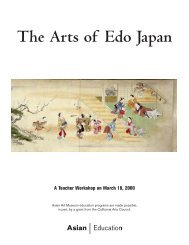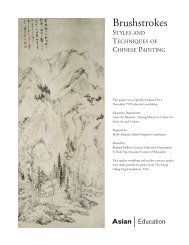Sacred Arts of Tibet (.pdf) - Asian Art Museum | Education
Sacred Arts of Tibet (.pdf) - Asian Art Museum | Education
Sacred Arts of Tibet (.pdf) - Asian Art Museum | Education
You also want an ePaper? Increase the reach of your titles
YUMPU automatically turns print PDFs into web optimized ePapers that Google loves.
<strong>Sacred</strong> <strong><strong>Art</strong>s</strong> <strong>of</strong> <strong>Tibet</strong><br />
phenomena being truly existent gives rise to desire, hate, envy, and the other ills <strong>of</strong> living beings. This<br />
ignorance <strong>of</strong> the true nature <strong>of</strong> reality is the ultimate root <strong>of</strong> all suffering. The desires and hatreds that<br />
arise from this ignorance bind one to suffering in the cycle <strong>of</strong> rebirths, a state called samsara. Each being<br />
has been born over and over in a beginningless series <strong>of</strong> lifetimes. The sufferings <strong>of</strong> birth, sickness, aging<br />
and death, as well as the terrible miseries <strong>of</strong> lower, even infernal states <strong>of</strong> being make samsara an endless<br />
source <strong>of</strong> suffering. Realizing the true nature <strong>of</strong> reality is the wisdom that frees one from samsara. Such<br />
wisdom arises only in the presence <strong>of</strong> pr<strong>of</strong>ound and endless compassion for the miseries <strong>of</strong> all other living<br />
beings. Therefore compassion is the natural expression <strong>of</strong> wisdom. Compassion arises with the realization<br />
<strong>of</strong> one’s innate and inalienable connectedness with each and every living being. True compassion entails a<br />
pr<strong>of</strong>ound and immutable desire to lead other beings to the state <strong>of</strong> ultimate wisdom where they are liberated<br />
from all suffering and attain true happiness.<br />
To aid his followers in their pursuit <strong>of</strong> liberating wisdom, Shakyamuni Buddha created the first monasteries<br />
in the history <strong>of</strong> the world, where they could live and meditate without being completely distracted by<br />
the world around them.<br />
The Bodhisattva<br />
As an advanced bodhisattva, one becomes powerful and effective in bringing about the liberation <strong>of</strong><br />
beings. Great bodhisattvas like Manjushri (Slide 8) or Avalokiteshvara (Slide 2) can save vast numbers <strong>of</strong><br />
beings from the miseries and terrors <strong>of</strong> the world and become widely worshiped by ordinary people as<br />
gods and goddesses. Avalokiteshvara is worshiped as Guanyin in China, Kannon in Japan, and in <strong>Tibet</strong> is<br />
known to take on many aspects, such as the Dalai Lama, in order to better encompass the welfare <strong>of</strong> the<br />
world.<br />
Vajrayana Buddhism<br />
Vajrayana Buddhism, which is the form <strong>of</strong> Buddhism practiced in <strong>Tibet</strong>, provides a great variety <strong>of</strong> special<br />
practices, meditations and rituals to accomplish the goals <strong>of</strong> cultivating compassion and the ultimate liberation<br />
<strong>of</strong> all living beings. Vajrayana is based on the esoteric doctrines <strong>of</strong> Buddha Shakyamuni given to<br />
selected disciples. It uses yogic techniques <strong>of</strong> meditation, mantra, and ritual to bring about psychological<br />
and physiological transformations. Initiations and empowerments are needed to understand and engage in<br />
these techniques, and to use the sacred implements such as the vajra and ghanta (bell) (Slide 10), sacred<br />
images (such as those in the museum collection), hand and body gestures (mudra), and sacred power<br />
words (mantra).<br />
<strong>Tibet</strong>an Buddhism comprises four lineages. All trace themselves back to Buddha Shakyamuni in an<br />
unbroken lineage <strong>of</strong> enlightened masters and disciples that extends down to the present day. They are distinguished<br />
much more by lineage than by any major difference in doctrine or practice. The four lineages<br />
are Gelukpa, Sakyapa, Nyingmapa and Kagyupa.<br />
Bön, <strong>Tibet</strong>’s Indigenous Belief<br />
Bön (Slide 20), <strong>Tibet</strong>’s indigenous religion, is a high form <strong>of</strong> religious ritualism primarily concerned with<br />
righting the causes <strong>of</strong> human ailment and misfortune and coexisting with the underlying forces <strong>of</strong> the<br />
universe. It focuses on the living, but has a clear sense <strong>of</strong> an afterlife and seeks to bring benefits and happiness<br />
in both this world and the world to come. The Bön outlook is basically one where humans are<br />
10<br />
<strong>Asian</strong> <strong>Art</strong> <strong>Museum</strong>
















